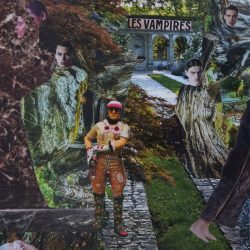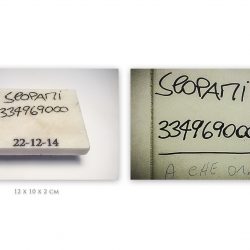work
-ismo
| category | Graphics |
| subject | Political / Social |
| tags | |
| base | 70 cm |
| height | 100 cm |
| depth | 0 cm |
| year | 2023 |
-ism (2023)
Print on Whiteback satin HR paper, 100X70cm
1/5
“[...] a true manifesto, depicting Filippo Tommaso Marinetti with his face covered by a ski mask. Around him, many ‘ad-libs’, perhaps the most used by trap artists. The reference is clear: the work recalls the famous cover of the book Zang Tumb Tuuum. Adrianopoli ottobre 1912. Parole in libertà, which Marinetti himself published in 1914. This famous volume is one of the first examples of Paroliberismo, the literary style created by Futurism, where sentences and periods do not follow the traditional syntactic-grammatical order. [...] The Futurists have new poetic needs, and Paroliberismo responds to one of these: the ability to bring words to a more natural and essential level, with the capacity to give free rein to one's expressiveness, something that would not have been possible if they had followed traditional syntactic structures.
Trap also emerges as a disruptive phenomenon, first breaking into the music scene and then conquering all other areas. On one hand, we see an impoverishment of the language itself, and on the other, the arrival of new words that come from and feed into everyday slang.
Now, sound and musical base take on greater importance than words and lyrics. And it is precisely from this reflection that plurale realizes -ism, almost as an attempt at denunciation. Here too, as with the Futurists, words are invented and represent an important novelty when viewed as a form of expression; however, what changes is the context in which they are inserted. With trap, we face violent, retrograde, and toxic themes, and the same suffix -ism, used to indicate a literary and artistic movement of great novelty, is betrayed by those same ideals that trap music seems to profess.”
from 'SNITCH. Phenomenology of a changing Italy', critical text by Alessio Vigni
Print on Whiteback satin HR paper, 100X70cm
1/5
“[...] a true manifesto, depicting Filippo Tommaso Marinetti with his face covered by a ski mask. Around him, many ‘ad-libs’, perhaps the most used by trap artists. The reference is clear: the work recalls the famous cover of the book Zang Tumb Tuuum. Adrianopoli ottobre 1912. Parole in libertà, which Marinetti himself published in 1914. This famous volume is one of the first examples of Paroliberismo, the literary style created by Futurism, where sentences and periods do not follow the traditional syntactic-grammatical order. [...] The Futurists have new poetic needs, and Paroliberismo responds to one of these: the ability to bring words to a more natural and essential level, with the capacity to give free rein to one's expressiveness, something that would not have been possible if they had followed traditional syntactic structures.
Trap also emerges as a disruptive phenomenon, first breaking into the music scene and then conquering all other areas. On one hand, we see an impoverishment of the language itself, and on the other, the arrival of new words that come from and feed into everyday slang.
Now, sound and musical base take on greater importance than words and lyrics. And it is precisely from this reflection that plurale realizes -ism, almost as an attempt at denunciation. Here too, as with the Futurists, words are invented and represent an important novelty when viewed as a form of expression; however, what changes is the context in which they are inserted. With trap, we face violent, retrograde, and toxic themes, and the same suffix -ism, used to indicate a literary and artistic movement of great novelty, is betrayed by those same ideals that trap music seems to profess.”
from 'SNITCH. Phenomenology of a changing Italy', critical text by Alessio Vigni

















